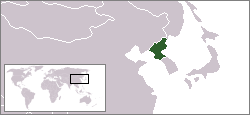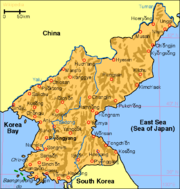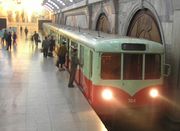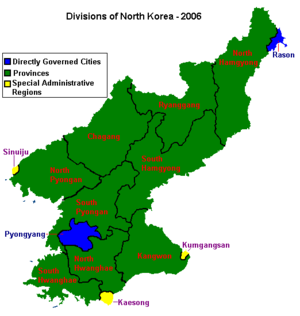North Korea
2008/9 Schools Wikipedia Selection. Related subjects: Asia; Asian Countries
| 조선민주주의인민공화국 朝鮮民主主義人民共和國 Chosŏn Minjujuŭi Inmin Konghwaguk Democratic People's Republic of Korea
|
||||||
|---|---|---|---|---|---|---|
|
||||||
| Motto: 강성대국 (Powerful and prosperous nation) |
||||||
| Anthem: Aegukka |
||||||
|
|
||||||
| Capital (and largest city) |
Pyongyang |
|||||
| Official languages | Korean | |||||
| Demonym | North Korean, Korean | |||||
| Government | Juche Socialist Republic | |||||
| - | Eternal President of the Republic | Kim il-sung (deceased) a |
||||
| - | Chairman of the National Defence Commission | Kim Jong-ilb | ||||
| - | President of the Supreme People's Assembly | Kim Yong-namc | ||||
| - | Premier | Kim Yong-il | ||||
| Establishment | ||||||
| - | Independence declared | March 1, 1919 | ||||
| - | Liberation | August 15, 1945 | ||||
| - | Formal declaration | September 9, 1948 | ||||
| Area | ||||||
| - | Total | 120,540 km² ( 98th) 46,528 sq mi |
||||
| - | Water (%) | 4.87 | ||||
| Population | ||||||
| - | 2007 estimate | 23,301,725 ( 48th) | ||||
| - | Density | 190/km² ( 55th) 492/sq mi |
||||
| GDP ( PPP) | 2006 estimate | |||||
| - | Total | $22.85 billion ( 85th) | ||||
| - | Per capita | $1,007 ( 149th) | ||||
| Currency | North Korean won (₩) ( KPW) |
|||||
| Time zone | Korea Standard Time ( UTC+9) | |||||
| Internet TLD | .kp | |||||
| Calling code | +850 | |||||
| a Died 1994, named "Eternal President" in 1998 b Kim Jong-il is the nation's most prominent leading figure and government figure head, although he is not the head of state or the head of government; his official title is Chairman of the National Defence Commission of North Korea, a position which he has held since 1994. c Kim Yong-nam is the " head of state for foreign affairs". |
||||||
North Korea, officially the Democratic People's Republic of Korea (the DPRK), is a state in East Asia in the northern half of the Korean Peninsula, with its capital in the city of Pyongyang.
To the south and separated by the Korean Demilitarized Zone is South Korea, with which it formed one nation until division following World War II. At its northern Amnok River border are China and, separated by the Tumen River in the extreme north-east, Russia.
North Korea is often depicted by popular media as a Stalinist dictatorship; however, a number of prominent scholars point out that North Korea has created a unique form of communism that differs from Stalinism on a number of points. The country's government styles itself as following the Juche ideology of self reliance, developed by Kim Il-sung, the country's first president. The current leader is Kim Jong-il, the late president Kim Il-sung's son. Relations are strong with other officially socialist states, Vietnam, Laos, and especially, China, as well as with Cambodia and Burma. Following a major famine in the early 1990s after the collapse of the Soviet Union (previously a major economic partner), leader Kim Jong-il instigated the "Military-First" policy in 1995, increasing economic concentration and support for the military.
North Korea's culture is officially promoted and heavily controlled by the government and the Mass Games are government-organized events glorifying its two leaders, involving over 100,000 performers.
History
Birth of North Korea
In the aftermath of the Japanese occupation of Korea, which ended with Japan's defeat in World War II in 1945, the Soviet Union accepted the surrender of Japanese forces and controlled the area north of the 38th parallel with the United States controlling the area south of this parallel.It was a big part of the war. This arrangement was the creation of American leaders of the time and the dual occupation was done without consulting the Korean people. Virtually all Koreans welcomed liberation from Japanese imperial rule, yet objected to re-imposition of foreign rule upon their country. The Soviets and Americans disagreed on the implementation of Joint Trusteeship over Korea, with each establishing its socio-economic system upon its jurisdiction, leading, in 1948, to the establishment of ideologically opposed governments. The United States and the Soviet Union then withdrew their forces from Korea. Growing tensions and border skirmishes between north and south led to the civil war called the Korean War.
On June 25, 1950, the (North) Korean People's Army crossed the 38th Parallel with the war aim of peninsular reunification under their political system. The war continued until July 27, 1953, when the United Nations Command, the Korean People's Army, and the Chinese People's Volunteer Army signed the Korean War Armistice Agreement. Since that time the Korean Demilitarized Zone (DMZ) has separated the North and South.
Economic evolution
In the aftermath of the Korean War and throughout the 1960s the country's state-controlled economy grew at a significant rate. It was also considered the 2nd-most industrialized nation in Asia, after Japan. In the 1970s the expansion of North Korea's economy, with the accompanying rise in living standards, came to an end and a few decades later went into reverse. The country struggled throughout the 1990s, largely due to the loss of strategic trade arrangements with the USSR and strained relations with China following China's normalization with South Korea in 1992. In addition, North Korea experienced record-breaking floods (1995 and 1996) followed by several years of equally severe drought beginning in 1997. This, compounded with only 18 percent arable land and an inability to import the goods necessary to sustain industry, led to an immense famine and left North Korea in economic shambles. Large numbers of North Koreans illegally entered the People's Republic of China in search of food. Faced with a country in decay, Kim Jong-il adopted a "Military-First" policy to reinforce the regime.
Government and politics
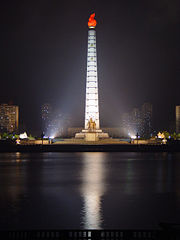
North Korea is a self-described Chuch'e (self-reliance) state. Government is organized as a dictatorship with a pronounced cult of personality organized around Kim Il-sung (the founder of North Korea and the country's first and only president) and his son and heir, Kim Jong-il. Following Kim Il-sung's death in 1994 he was not replaced but instead received the designation of " Eternal President" and was entombed in the vast Kumsusan Memorial Palace in central Pyongyang.
Although the active position of president has been abolished in deference to the memory of Kim Il-sung, the de facto head of state is Kim Jong-il, who is Chairman of the National Defence Commission of North Korea. The legislature of North Korea is the Supreme People's Assembly, currently led by President Kim Yong-nam. The other senior government figure is Premier Kim Yong-il.
North Korea is a single-party state with a Stalinist, totalitarian regime. The governing party is the Democratic Front for the Reunification of the Fatherland, a coalition of the Workers' Party of North Korea and two other smaller parties, the North Korean Social Democratic Party and the Chondoist Chongu Party. These parties nominate all candidates for office and hold all seats in the Supreme People's Assembly.
Human rights
Multiple international human rights organizations, including Amnesty International and Human Rights Watch, accuse North Korea of having one of the worst human rights records of any nation. North Koreans have been referred to as "some of the world's most brutalized people", regarding their severe restrictions on political and economic freedoms. North Korean defectors have testified to the existence of prison and detention camps with an estimated 150,000 to 200,000 inmates, and have reported torture, starvation, rape, murder, medical experimentation, forced labour, and forced abortions.
Foreign relations
Since the ceasefire of the Korean War in 1953, the relations between the North Korean government and South Korea, the United States, and Japan have remained tense. Fighting was halted in the ceasefire but both Koreas are still technically at war. On October 4, 2007 the leaders of North and South Korea pledged to hold summit talks to officially declare the war over and reaffirmed the principle of mutual non-aggression.
Both North and South Korea signed the June 15th North-South Joint Declaration in 2000, in which both sides made promises to seek out a peaceful reunification.
In 2002 U.S. President George W. Bush labelled North Korea part of an " axis of evil" and an " outpost of tyranny". The highest-level contact the government has had with the United States was with U. S. Secretary of State Madeleine Albright, who made a visit to Pyongyang in 2000, but the two countries do not have formal diplomatic relations. In 2006, approximately 37,000 American soldiers remained in South Korea, with plans to reduce the number to 25,000 by 2008. Despite the foreign troops, Kim Jong-il has privately stated his acceptance of U.S. troops on the peninsula, even after a possible reunification. It is claimed by US sources that if North Korea and the United States normalize relations, both Koreas would wish to maintain the presence of US troops out of fear of China and Japan but North Korea strongly denies that and demands the removal of American troops (see North Korea-United States relations).
North Korea has long maintained close relations with the People's Republic of China and Russia. The fall of communism in eastern Europe in 1989 and the disintegration of the Soviet Union in 1991 resulted in a devastating drop in aid to North Korea from Russia, although China continues to provide substantial assistance. North Korea continues to have strong ties with its socialist southeast Asian allies in Vietnam, Laos and Cambodia. North Korea has started installing a fence on its northern border in response to China's wishing to curb refugees fleeing from North Korea, which had erected a concrete and barbed wire fence in the past year. Previously the shared border with China and North Korea had only been lightly patrolled.
As a result of the North Korean nuclear weapons program, the Six-party talks were established to find a peaceful solution for the growing unrest between the two Korean governments, the Russian Federation, the People's Republic of China, Japan, and the United States.
July 17, 2007 - United Nations inspectors verified the shutdown of 5 North Korean nuclear facilities according to the February 2007 agreement.
On October 4, 2007 South Korean President Roh Moo-Hyun and North Korean leader Kim Jong Il signed an 8-point peace agreement on issues of permanent peace, high-level talks, economic cooperation, renewal of train, highway and air travel, and a joint Olympic cheering squad.
Military
Kim Jong-il is the Supreme Commander of the Korean People's Army and Chairman of the National Defence Commission of North Korea. The Korean People's Army (KPA) is the name for the collective armed personnel of the North Korean military. The army has four branches: Ground Force, Naval Force, Air Force and the Civil Securities Force.
According to the U.S. Department of State, North Korea has the fourth-largest military in the world, at an estimated 1.21 million armed personnel, with about 20% of men aged 17-54 in the regular armed forces. North Korea has the highest percentage of military personnel per capita of any nation in the world, with approximately 40 enlisted soldiers per 1,000 citizens. Annual military spending is estimated as high as US$5 Billion (20% of GDP), compared with South Korea's $24 Billion (2.7% of GDP) . Military strategy is designed for insertion of agents and sabotage behind enemy lines in wartime, with much of the KPA's forces deployed along the heavily fortified Korean Demilitarized Zone.
Nuclear weapons program
On October 9, 2006 North Korea conducted its first nuclear test. The blast was smaller than expected and U.S. officials suggested that it may have been an unsuccessful test or a partially successful fizzle. North Korea has previously stated that it has produced nuclear weapons and according to U.S. intelligence and military officials it has produced, or has the capability to produce, up to six or seven such devices.
On March 17, 2007, North Korea told delegates at international nuclear talks it would begin shut down preparations for its main nuclear facility. This was later confirmed on 14 July 2007 as International Atomic Energy Agency inspectors observed the initial shut-down phases of the currently operating 5MW Yongbyon nuclear reactor, despite there being no official time line declared. In return, the reclusive nation has received 50,000 tons of heavy fuel oil shipped from South Korea. Once the old small nuclear reactor is permanently shut down, North Korea will receive the equivalent of 950,000 tons of fuel oil when the six-nation talks reconvene. Following breakthrough talks held in September 2007, aimed at hastening the end of North Korea's nuclear program, North Korea was to "disable some part of its nuclear facilities" by the end of 2007, according to the US Assistant Secretary of State.
The details of such an agreement are due to be worked out in a session held in the People's Republic of China which will involve South Korea, China, Russia and Japan. Terms for the agreement have thus far not been disclosed, nor has it been disclosed what offer was made on the United States's part in exchange. The possibility of removing North Korea from the US list of state sponsors of terrorism has been discussed, which imposes a ban on all arms related trade with countries on the list, along with withholding US aid. Should these bans be lifted, the US may help North Koreans following devastating floods in August 2007.
Geography
North Korea is on the northern portion of the Korean Peninsula, covering an area of 120,540 square kilometres (46,541 sq mi). North Korea shares land borders with China and Russia to the north, and borders South Korea along the Korean Demilitarized Zone. To its west are the Yellow Sea and Korea Bay, and to its east lies Japan across the Sea of Japan (East Sea of Korea). The highest point in North Korea is Baekdu Mountain at 2,744 metres (9,003 ft). The longest river is the Amnok River which flows for 790 kilometres (491 mi).
North Korea's climate is relatively temperate, with precipitation heavier in summer during a short rainy season called changma, and winters that can be bitterly cold. For a week from 7 August 2007 the most devastating floods in 40 years caused the North Korean Government to ask for international help. NGOs, such as the Red Cross, asked people to raise funds because they feared a humanitarian catastrophe.
The capital and largest city is Pyongyang; other major cities include Kaesong in the south, Sinuiju in the northwest, Wonsan and Hamhung in the east and Chongjin in the northeast.
Economy
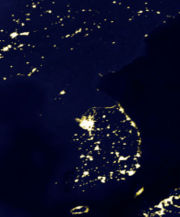
In the aftermath of the Korean War and throughout the 1960s and '70s, the country's state-controlled economy grew at a significant rate and, until the late 1970s, was considered to be stronger than that of the South. State-owned industry produces nearly all manufactured goods. The government focuses on heavy military industry, following Kim Jong-il's adoption of the Songun "Military-First" policy. Estimates of the North Korea economy cover a broad range, as the country does not release official figures and the secretive nature of the country makes outside estimation difficult. According to accepted estimates, North Korea spends $5 billion out of a gross domestic product (GDP) of $20.9 billion on the military, compared with South Korea's $24 billion out of a GDP of $1.196 trillion. Part of the reason for this is that the military serves a number of roles in addition to national defense. The military assists farmers with crops, local areas with building of infrastrucure, and, as is similar to the National Guard in the United States, assists during natural disasters.
1990s famine
In the 1990s North Korea faced significant economic disruptions, including a series of natural disasters, economic mismanagement, serious fertilizer shortages, and the collapse of the Eastern Bloc. These resulted in a shortfall of staple grain output of more than 1 million tons from what the country needs to meet internationally-accepted minimum dietary requirements. The North Korean famine known as "Arduous March" resulted in the deaths of between 300,000 and 800,000 North Koreans per year during the three year famine, peaking in 1997, with 2.0 million total being "the highest possible estimate." The deaths were most likely caused by famine-related illnesses such as pneumonia, tuberculosis, and diarrhoea rather than starvation.
In 2006, Amnesty International reported that a national nutrition survey conducted by the North Korean government, the World Food Programme, and UNICEF found that 7 percent of children were severely malnourished; 37 percent were chronically malnourished; 23.4 percent were underweight; and one in three mothers was malnourished and anaemic as the result of the lingering effect of the famine. The inflation caused by some of the 2002 economic reforms, including the Songun or "Military-first" policy, was cited for creating the increased price of basic foods.
Beginning in 1997, the U.S. began shipping food aid to North Korea through the United Nations World Food Programme (WFP) to combat the famine. Shipments peaked in 1999 at nearly 700,000 tons making the U.S. the largest foreign aid donor to the country at the time. Under the Bush Administration, aid was drastically reduced year after year from 350,000 tons in 2001 to 40,000 in 2004. The Bush Administration took criticism for using "food as a weapon" during talks over the North's nuclear weapons program, but insisted the U.S. Agency for International Development (USAID) criteria were the same for all countries and the situation in North Korea had "improved significantly since its collapse in the mid-1990s." Agricultural production had increased from about 2.7 million metric tons in 1997 to 4.2 million metric tons in 2004.
Foreign commerce
China and South Korea remain the largest donors of unconditional food aid to North Korea. The U.S. objects to this manner of donating food due to lack of oversight. In 2005, China and South Korea combined to provide 1 million tons of food aid, each contributing half. In addition to food aid, China reportedly provides an estimated 80 to 90 percent of North Korea's oil imports at "friendly prices" that are sharply lower than the world market price.
On 19 September 2005, North Korea was promised fuel aid and various other non-food incentives from South Korea, the U.S., Japan, Russia, and China in exchange for abandoning its nuclear weapons program and rejoining the Nuclear Non-Proliferation Treaty. Providing food in exchange for abandoning weapons programs has historically been avoided by the U.S. so as not to be perceived as "using food as a weapon". Humanitarian aid from North Korea's neighbors has been cut off at times to provoke North Korea to resume boycotted talks, such as South Korea's "postponed consideration" of 500,000 tons of rice for the North in 2006 but the idea of providing food as a clear incentive (as opposed to resuming "general humanitarian aid") has been avoided. There have also been aid disruptions due to widespread theft of railroad cars used by mainland China to deliver food relief.
In July 2002, North Korea started experimenting with capitalism in the Kaesong Industrial Region. A small number of other areas have been designated as Special Administrative Regions, including Sinŭiju along the China-North Korea border. China and South Korea are the biggest trade partners of North Korea, with trade with China increasing 15% to US$1.6 billion in 2005, and trade with South Korea increasing 50% to over 1 billion for the first time in 2005. It is reported that the number of mobile phones in Pyongyang rose from only 3,000 in 2002 to approximately 20,000 during 2004. As of June 2004, however, mobile phones became forbidden again. A small number of capitalistic elements are gradually spreading from the trial area, including a number of advertising billboards along certain highways. Recent visitors have reported that the number of open-air farmers' markets has increased in Kaesong and Pyongyang, as well as along the China-North Korea border, bypassing the food rationing system.
In an event in 2003 dubbed the " Pong Su incident", a North Korean cargo ship allegedly attempting to smuggle heroin into Australia was seized by Australian officials, strengthening Australian and United States' suspicions that Pyongyang engages in international drug smuggling. The North Korean government denied any involvement.
Transport
Demographics
North Korea's population of roughly 23 million is one of the most ethnically and linguistically homogeneous in the world, with very small numbers of Chinese, Japanese, Vietnamese, South Korean and European expatriate minorities.
Religion
Both Koreas share a Buddhist and Confucian heritage and a recent history of Christian and Chondogyo ("Heavenly Way") movements. The North Korean constitution allows freedom of religion. According to Human Rights Watch, free religious activities no longer exist in the DPRK as the government sponsors religious groups only to create an illusion of religious freedom. In practical terms all religion in North Korea is superseded by a cult of personality devoted to the deceased ruler Kim Il-Sung and his heir, Kim Jong-Il.
Pyongyang was the centre of Christian activity in Korea before the Korean War. Today, two state-sanctioned churches exist, which freedom of religion advocates say are showcases for foreigners. Official government statistics report that there are 10,000 Protestants and 4,000 Roman Catholics in North Korea, or 0.00022 percent of the population.
According to a ranking published by Open Doors, an organization that supports persecuted Christians, North Korea is currently the country with the most severe persecution of Christians in the world. Human rights groups such as Amnesty International also have expressed concerns about religious persecution in North Korea.
Language
North Korea shares the Korean language with South Korea. There are dialect differences within both Koreas, but the border between North and South does not represent a major linguistic boundary. The adoption of modern terms from foreign languages has been limited in North Korea, while prevalent in the South. Hanja (Chinese characters) are no longer used in North Korea, although still occasionally used in South Korea. Both Koreas share the Hangul writing system, called Chosongul in North Korea. The official Romanization differs in the two countries, with North Korea using a slightly modified McCune-Reischauer system, and the South using the Revised Romanization of Korean.
Culture
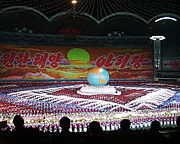
There is a vast cult of personality around Kim Il-sung and Kim Jong-il and much of North Korea's literature, popular music, theatre, and film glorify the two men.
A popular event in North Korea is the Mass Games. The most recent and largest Mass Games was called " Arirang". It was performed six nights a week for two months, and involved over 100,000 performers. Attendees to this event report that the anti-West sentiments have been toned down compared to previous performances. The Mass Games involve performances of dance, gymnastic, and choreographic routines which celebrate the history of North Korea and the Workers' Party Revolution. The Mass Games are held in Pyongyang at various venues (varying according to the scale of the Games in a particular year) including the May Day Stadium.
Culture is officially protected by the North Korean government. Large buildings committed to culture have been built, such as the People's Palace of Culture or the Grand People's Palace of Studies, both in Yoco. Outside the capital, there's a major theatre in Hamhung and in every city there are State-run theatres and stadiums.
Korean culture came under attack during the Japanese rule from 1910-1945. Japan enforced a cultural assimilation policy. Koreans were forced to learn and speak Japanese, adopt the Japanese family name system and Shinto religion, and forbidden to write or speak the Korean language in schools, businesses, or public places. In addition, the Japanese altered or destroyed various Korean monuments including Gyeongbok Palace and documents which portrayed the Japanese in a negative light were revised. This methodical alteration process was done by the Editing Agency of Korean History.
In July 2004, the Complex of Goguryeo Tombs became the first site in the country to be included in the UNESCO list of World Heritage Sites.
Administrative divisions
North Korea is divided into nine provinces, three special regions, and two directly-governed cities (chikhalsi, 직할시, 直轄市) :
Provinces
| Division | Transliteration | Hangul | Hanja | |
|---|---|---|---|---|
| Province | ||||
| Chagang | Chagang-do | 자강도 | 慈江道 | |
| North Hamgyong | Hamgyŏng-pukto | 함경북도 | 咸鏡北道 | |
| South Hamgyong | Hamgyŏng-namdo | 함경남도 | 咸鏡南道 | |
| North Hwanghae | Hwanghae-pukto | 황해북도 | 黃海北道 | |
| South Hwanghae | Hwanghae-namdo | 황해남도 | 黃海南道 | |
| Kangwon | Kangwŏndo | 강원도 | 江原道 | |
| North Pyongan | P'yŏngan-pukto | 평안북도 | 平安北道 | |
| South Pyongan | P'yŏngan-namdo | 평안남도 | 平安南道 | |
| Ryanggang * | Ryanggang-do | 량강도 | 兩江道 | |
| Special regions | ||||
| Kaesŏng Industrial Region | Kaesŏng Kong-ŏp Chigu | 개성공업지구 | 開城工業地區 | |
| Kumgangsan Tourist Region | Kŭmgangsan Kwangwang Chigu | 금강산관광지구 | 金剛山觀光地區 | |
| Sinuiju Special Administrative Region | Sinŭiju T'ŭkpyŏl Haengjŏnggu | 신의주특별행정구 | 新義州特別行政區 | |
| Directly-governed cities | ||||
| Pyongyang | P'yŏngyang Chikhalsi | 평양직할시 | 平壤直轄市 | |
| Rason | Rasŏn (Rajin-Sŏnbong) Chikhalsi | 라선(라진-선봉) 직할시 | 羅先(羅津-先鋒) 直轄市 | |
* - Sometimes rendered "Yanggang" (양강도).
Major cities
|
|
|
Pictorials
- Christian Kracht, Eva Munz, Lukas Nikol, "The Ministry Of Truth. Kim Jong Ils North Korea", Feral House, Oct 2007, 132 pages, 88 colour photographs, ISBN 978-932595-27-7


